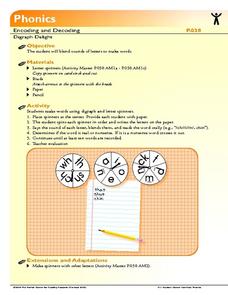Florida Center for Reading Research
Word Steps
Blending basic CVC letters to make words is one of the first steps to independent reading. Provided here are several images of stairs and several letters to cut and arrange. The learner rearranges the letters to form CVC patterns, sounds...
Florida Center for Reading Research
Phonics: Encoding and Decoding, A Digraph A Word
Learners view a series of images, then choose digraphs, consonants, and vowels to spell out the object's name on each card.
Florida Center for Reading Research
Phonics: Encoding and Decoding, Make-A-Word
Little learners place a picture card on a magnetic board, say the name of the object on the card, then sift through alphabet magnets to find and spell the word they said.
Florida Center for Reading Research
Phonics: Encoding and Decoding, Letter Cube Blending
Emergent readers use a letter cube to identify, blend, and make words. They roll each of the three-letter cubes, mark down the letters they rolled, then blend the letter sounds together to make a word. They record each word on a...
Florida Center for Reading Research
Phonics: Encoding and Decoding, Digraph Delight
There are three spinners to use in this phonic activity. Spinner one contains digraphs, spinner two contains vowels, and spinner three contains consonants. Learners spin each spinner, write down the letters they get, blend them to make a...
Florida Center for Reading Research
Phonics: Encoding and Decoding, Three-In-One
Scholars use the provided pack of alphabet cards to construct basic CVC words, then write down each word they make in one of two columns. Column one is for real words and column two is for nonsense words.
Florida Center for Reading Research
Phonics: Encoding and Decoding, Vowel Stars
Learners are given a star; each star contains a c_c form in the center and vowels on each point. They use the vowels to fill in the blank between the consonants making a simple CVC word. They write each word they make on a piece of paper.
Curated OER
Caesar Ciphers: An Introduction to Cryptography
High schoolers encode and decode messages using a Caesar Cipher. In this encoding and decoding messages using a Caesar Cipher lesson, students discuss cryptography and how it is used. High schoolers make a Caesar wheel to encode and...
Google
Google for Education: Ciphering a Sentence
In this lesson, the students have a goal to map each alphabet letter to a number in the range 1-26. They use some simple rules to create this mapping and then use this mapping to encode a sentence.
Other
Nat'l Security Agency: National Cryptologic Museum
On this site one can find the National Security Agency's history of cryptology, some online exhibits, and sections on mathematics, education, and more.
Shodor Education Foundation
Shodor Interactivate: Caesar Cipher
Create your own affine cipher for encoding and decoding messages. Input your own constant and multiplier, then input a message to encode.
ClassFlow
Class Flow: Dna Replication
[Free Registration/Login Required] With this flipchart students will analyze how biological traits are passed on to successive generations.
Braingle
Braingle: Cryptography Brain Teasers
Test your critical thinking skills with a variety of cryptography brain teasers, phrases or expressions "encoded in some way." Solve the teasers provided at this site, and submit your own for others to try!
Curated OER
Behind the Scenes
Here are stories of Military Intelligence as told by those who were in Harms Way", "In The Field", and "Behind the Scenes.














